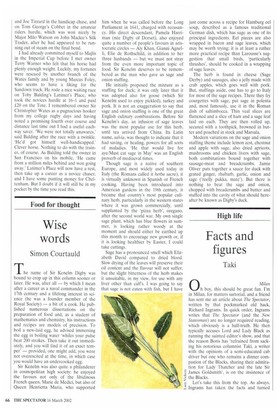Food for thought
Wise words
Simon Courtauld
The name of Sir Kenelm Digby was bound to crop up in this column sooner or later. He was, after all — by which I mean after a career as a naval commander in the 17th century and a lifelong interest in science (he was a founder member of the Royal Society) — a bit of a cook. He published numerous dissertations on the preparation of food and, as a student of mathematics and chemistry, his instructions and recipes are models of precision. To boil a new-laid egg, he advised immersing the egg in boiling water 'whiles your pulse beat 200 strokes. Then take it out immediately, and you will find it of an exact temper' — provided, one might add, you were not overexcited at the time, in which case you would have an undercooked egg.
Sir Kenelm was also quite a philanderer in cosmopolitan high society: he enjoyed the favours not only of the libidinous French queen, Marie de Medici, but also of Queen Henrietta Maria, who supported him when he was called before the Long Parliament in 1641, charged with recusancy. His direct descendant, Pamela Harriman (née Digby of Dorset), also enjoyed quite a number of people's favours in aristocratic circles — Aly Khan, Gianni Agnelli, Elie de Rothschild, in addition to her three husbands — but we must not stray from the even more important topic of food. Sir Kenelm deserves to be remembered as the man who gave us sage and onion stuffing.
He initially proposed the mixture as a stuffing for duck; it was only later that it was adopted also for goose (which Sir Kenelm used to enjoy pickled), turkey and pork. It is not an exaggeration to say that sage and onion stuffing is one of the great English culinary combinations. Before Sir Kenelm's day, an infusion of sage leaves was the most popular use for this herb, until tea arrived from China. Its Latin name, salvia, was thought to indicate that it had saving, or healing, powers for all sorts of maladies. 'He that would live for aye/Must eat sage in May' was an English proverb of mediaeval times.
Though sage is a native of southern Europe, and most widely used today in Italy (the Romans called it herba sacra), it is virtually unknown in Spanish or French cooking. Having been introduced into American gardens in the 19th century, it became that country's most popular culinary herb, particularly in the western states where it was grown commercially, until supplanted by the 'pizza herb', oregano, after the second world war. My own single sage plant, which has blue flowers in summer, is looking rather woody at the moment and should either be earthed up this month to encourage new growth or, if it is looking healthier by Easter, I could take cuttings.
Sage has a pronounced smell which Elizabeth David compared to dried blood. Slow drying of the leaves will preserve their oil content and the flavour will not suffer; but the slight bitterness of the herb makes it unsuitable, in my view, for use with any liver other than calf's. I was going to say that sage is not eaten with fish, but I have just come across a recipe for Hamburg eel soup, described as a famous traditional German dish, which has sage as one of its principal ingredients. Eel pieces are also wrapped in bacon and sage leaves, which may be worth trying; it is at least a rather more practical recipe than Larousse's suggestion that small birds, 'particularly thrushes', should be cooked in a wrapping of sage leaves.
The herb is found in cheese (Sage Derby) and sausages, also a jelly made with crab apples, which goes well with pork. But, stuffings aside, one has to go to Italy for most of the sage recipes. There they fry courgettes with sage, put sage in polenta and, most famously, use it in the Roman dish of saltimbocca. Thin veal slices are flattened and a slice of ham and a sage leaf laid on each. They are then rolled up, secured with a toothpick, browned in butter and poached in stock and Marsala.
Modern variations on the sage and onion stuffing theme include lemon zest, chestnut and apple with sage, also dried apricots, mushrooms and chicken livers with sage, both combinations bound together with sausage-meat and breadcrumbs. Jamie Oliver puts together a sauce for duck with grated ginger, rhubarb, garlic, onion and sage ('reelly pukka. mate'). But there is nothing to beat the sage and onion, chopped with breadcrumbs and butter and stuffed into the cavity of what should hereafter be known as Digby's duck.
















































































 Previous page
Previous page